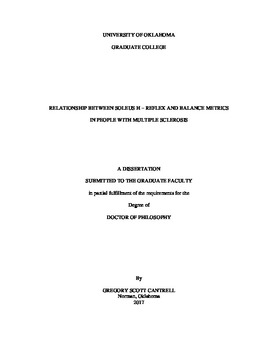| dc.description.abstract | Multiple sclerosis (MS) is a chronic immune-mediated disease that wreaks havoc on the central nervous system (CNS). The disease attacks and degrades the myelin sheath that insulates axons in the CNS, as well as the cells that generate myelin known as oligodendrocytes. In chronic cases it can even transect the axons themselves. The degradation leads to impaired conduction of electrical signals that travel to and from the CNS. Due to the variability in degradation sites symptoms associated with MS differ considerably from person to person. However, common symptoms consist of muscle weakness, fatigue, and impaired mobility and balance. Recently, the notion of bilateral asymmetry has become more commonplace in MS research, and has been observed in many physiological variables, such as aerobic capacity, muscular strength and power, as well as skeletal loading. Yet, one area that has not been investigated involves spinal reflexes, particularly the soleus Hoffmann (H) reflex. Of importance, bilateral coordination reflexes between legs is necessary for tasks such as balance. PURPOSE: Therefore, the intent of this investigation was two-fold. First, to determine if the soleus H reflex was asymmetrical in a sample of people with MS; and secondly, is the asymmetry associated with impaired balance. METHODS: Eight volunteers with MS (Females = 5) and eight healthy volunteers (Females = 6) matched for age- and physical activity participated in this investigation. The MS patients had an average expanded disability status score of 3.1 ± 2.2 (median = 2, range = 1 to 6) indicating mild to moderate disability. The study consisted of six visits, five of which were for soleus reflex testing, one for balance testing, and the initial for necessary paperwork and familiarization to all experimental protocols. Electrical activity of the soleus muscle was recorded using electromyography electrodes placed over the soleus muscle. To contract the soleus muscle involuntarily (the muscle was in a resting state) a stimulating electrode was placed over the tibial nerve located on the posterior aspect of the knee in the popliteal fossa, and another placed just proximal to the patella. Electrical stimulation started at ~ 0.5 volts and increased by 0.25V every seven to ten seconds until the H reflex reached a peak (Hmax) and the direct muscle response (M wave) reached a plateau (Mmax). EMG tracings were analyzed to determine Hmax and Mmax in order to standardize the Hmax to the Mmax. Each leg was tested twice in random order, but only once per visit. To increase reliability in day-to-day variability stimulating and recording sites were traced with a permanent marker, and stimulation visits were scheduled for the same time. Within-limb Hmax / Mmax ratios were compared using paired t-tests. Both left and right leg Hmax / Mmax ratios were averaged and compared using independent t-tests. After averaging each leg an asymmetry score was calculated and compared between groups using independent t-tests. The asymmetry score was then correlated to balance performance collected using dynamic dual-force plates. Two balance tests were used: the sensory organization test (SOT) and limits of stability (LOS) test. Body composition was assessed with dual-energy x-ray absorptiometry (DXA). RESULTS: Within-limb Hmax / Mmax ratios were similar for both legs in the MS group (p > 0.05). Left leg within-limb Hmax / Mmax ratios were similar in the left leg (p > 0.05) but differed in the right leg (p < 0.05). When each leg was averaged together and compared no significant between leg differences were observed for either group (p > 0.05). When the averaged Hmax / Mmax ratios were converted into an asymmetry score a significant difference was observed between groups (p < 0.01), with the MS groups having a greater asymmetry score than the non-MS group. Asymmetry scores from each group were pooled and ran against the results from the SOT and LOS tests. Significant negative correlations were observed for condition four of the SOT and endpoint excursion, maximum excursion, and directional control from the LOS test in the forward direction (i.e., leaning forward). One significant positive correlation was observed between the pooled asymmetry scores and reaction time from the LOS test, also in the forward direction. No other significant correlations were observed between the asymmetry scores and the other conditions or the composite score of the SOT, or the other directions tested from the LOS test. Total body fat-mass and percent fat differed between groups (p < 0.05). No differences were observed in lower-leg composition results (p < 0.05). CONCLUSION: The results from this investigation further highlight the presence of bilateral asymmetries in MS patients, and that the soleus H reflex is significantly associated with many aspects of leaning forward. Of interest, is all asymmetries previously reported in the literature have required physical effort and/or motivation; however, the asymmetry observed in this investigation occurred in a resting muscle, which did not incorporate descending drive or require voluntary effort. | en_US |
